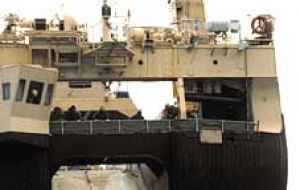MercoPress. South Atlantic News Agency
Japan begins whale hunt with Greenpeace on its heels
 The <i>Nisshin Maru</i>, a Japanese whaling factory ship hauling in a minke whale
The <i>Nisshin Maru</i>, a Japanese whaling factory ship hauling in a minke whale A Japanese whaling fleet has begun a five-month expedition that environmentalists say will hunt humpback whales for the first time in decades.
The Nisshin Maru, an 8,000-tonne ship, left Shimonoseki port for the Antarctic on Sunday, environmental group Greenpeace said, with other ships due to follow. The fleet aims to catch more than 1,000 whales before returning to port early next year, Greenpeace has said. "It's clearly commercial whaling in disguise and the aim for the Japanese government is to restart commercial whaling," Karli Thomas, leader of the Esperanza, Greenpeace's campaign ship. "The whaling fleet must be recalled now. If it is not, we will take direct, non-violent action to stop the hunt," she said. The Esperanzais aiming to intercept the fleet in Japanese waters in an attempt to stop the expedition. About 100 humpback and fin whales, which environmentalists say are both vulnerable species, are among the 1,000 whales that have been ordered to be hunted. The remainder will consist of minke whales. The Sea Shepherd Conservation Society said Japan was "viciously cruel" for hunting humpbacks, and has pledged to stop the mission. "Sea Shepherd will be hunting the whalers with the firm objective of intervention against their illegal activities," a Sea Shepherd statement said. The decision by Japan to hunt humpbacks is expected to draw criticism from Australia, which has already said that relations between the two countries could worsen if the hunt goes ahead. About 1.5 million whale watchers observe the northern migration of humpbacks along Australia's coast to breed each year, pumping an estimated $225m into the Australian economy. "It's important that Japan understands that the inclusion of humpbacks will have an impact on perceptions of Japan in Australia," Malcolm Turnbull, Australia's environment minister, said earlier this year. Japan says its whaling programme is carried out for scientific research and aids the understanding of whale stocks and species. Fisheries officials have in the past protested against the activities of environmental organisations. Japan, which kills more than 1,000 whales a year in the Antarctic and the Pacific Ocean, abandoned its last Antarctic whale-hunting season in March after fire broke out on the Nisshin Maru, killing one crew member. Japan observed an international moratorium and halted commercial whaling in 1986, but then resumed the following year. Norway and Iceland defy the moratorium outright. Whale meat is sold for consumption under rules set by the International Whaling Commission, although demand among Japanese consumers has been falling. ?Humpback whales are rorqual whales, part of the baleen family. They are filter feeders, eating krill, plankton and small fish. ?They grow to 50ft long and can weigh 50 tons. Females are bigger than males. ?Humpbacks can live for 60 years. They are noted for the males' complex singing. ?Estimates of their numbers range from 15,000 to 70,000 distributed between the North Pacific, North Atlantic and southern hemisphere. ?They feed in summer in the waters of the Arctic or Antarctic before migrating to warmer waters for the winter. ?A moratorium on hunting humpbacks was introduced by the International Whaling Commission in 1963 after they had been hunted to the verge of extinction. ?Greenland and Saint Vincent and the Grenadines were each allowed to catch one humpback last year as part of a subsistence programme. They were also hunted by the former Soviet Union until 1973.




Top Comments
Disclaimer & comment rulesCommenting for this story is now closed.
If you have a Facebook account, become a fan and comment on our Facebook Page!